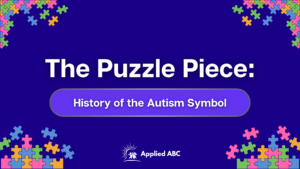The puzzle piece has a considerable history in association with autism. However, its use and interpretations have sparked debate within the autism community about the symbol’s meaning. In examination, some groups have explored the potential for alternative symbols in the context of the neurodiversity movement.
Origins of the Autism Puzzle Symbol
The autism puzzle piece was first introduced in 1963 by the National Autistic Society (NAS) in the United Kingdom. The original design also depicted a crying child within the puzzle piece. This imagery was intended to reflect the challenge it presented to those who attempted to study and understand the condition.
Meanings and Interpretations
Over time, the autism puzzle piece became a pervasive symbol in autism advocacy, particularly in raising awareness. Its use by various organizations helped solidify its place in public consciousness. The puzzle piece was often seen as representing the complexity and diversity of the autism spectrum, like how individual pieces fit together to form a complete picture (33rd Square, 2023).
However, this interpretation has not been universally accepted. Some argue that the symbol suggests that autistic individuals are “puzzling” or “incomplete,” reinforcing negative stereotypes and a view of autism as a problem to be solved (Cross River Therapy, 2023). This perception can be harmful, implying that individuals with autism are missing a crucial component necessary to be whole.
Controversies and Criticisms
The autism puzzle piece has been increasingly criticized, particularly by those who have autism and advocates of the neurodiversity movement. Critics argue that the symbol perpetuates a deficit-based view of autism, which focuses on what individuals with autism lack in comparison to neurotypical norms rather than recognizing their unique strengths and perspectives (Rosqvist et al., 2020).
Additionally, the puzzle piece’s association with organizations that emphasized finding a “cure” for autism—rather than supporting the diverse ways of being presented by those living with autism presently—fueled controversy further. This perspective often leads to viewing autism as a condition to be “fixed,” which contrasts sharply with the neurodiversity movement that promotes acceptance and celebration of neurological differences (Cross River Therapy, 2023).
The Neurodiversity Movement and Alternative Symbols
The neurodiversity movement offers a different lens through which to view autism, challenging the medical model’s focus on deficits and pathologization. Instead, it frames autism as a natural variation in human neurology, deserving of respect and accommodation rather than correction. The paradigm shift emphasizes the strengths and unique contributions of neurodivergent individuals (Rosqvist et al., 2020; Robertson, 2010).
In response to the growing discomfort with the puzzle piece, many individuals with autism have begun to adopt alternative symbols. The rainbow infinity symbol, for instance, represents the infinite diversity within the autism spectrum and is seen as a more positive and inclusive emblem. It moves away from the notion of something missing or puzzling and instead highlights the full spectrum of human neurodiversity (33rd Square, 2023).
Inclusivity and Understanding
The history and evolution of the autism puzzle piece illustrate the changing landscape of autism advocacy and awareness. While the puzzle piece remains a widely recognized autism symbol, its use is increasingly questioned within the context of growing understanding and acceptance of neurodiversity. As the conversation continues to evolve, it is crucial to center the voices and experiences of those with autism, ensuring that the symbols and language used in advocacy accurately reflect the values of inclusivity, respect, and acceptance.
Understanding these dynamics can help parents, caregivers, and allies of autistic individuals navigate the complexities of autism advocacy. It encourages a move towards symbols and narratives that celebrate neurodivergent identities rather than marginalize them.
Sources Cited
Cross River Therapy. “The Meaning of the Autism Puzzle Piece Symbol.”
33rd Square. “Demystifying the Autism Puzzle Piece Symbol: Origins, Meanings and Controversies.”
Rosqvist, H.B, Brownlow, C., & O’Dell, L. (2020) “The Neurodiversity Paradigm: What Is It and What Does It Mean for People with Autism Spectrum Conditions?” Disability Studies Quarterly.
Robertson, S. M. (2010). “Neurodiversity, Quality of Life, and Autistic Adults: Shifting Research and Advocacy Priorities.” Disability Studies Quarterly.




